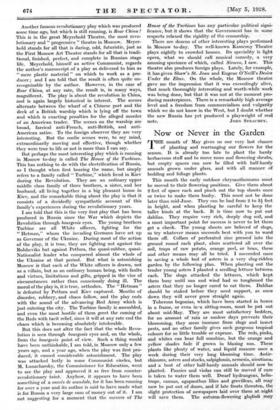Now or Never in the Garden
THE month of May gives us our very last chance of planting and rearranging our flowers for the season. It is already too late to plant the hardy herbaceous stuff and to move roses and flowering shrubs, but empty spaces can now be filled with half-hardy annuals grown under glass, and with all manner of bedding and foliage plants.
This month the early outdoor chrysanthemums must be moved to their flowering positions. Give them about 2 feet of space each and pinch out the top shoots once or twice to make them bushy. This must not be done later than mid-June. They can be had from 2 to 31 feet in height, and when planting be careful to keep the taller kinds at the back. It is time now to put out dahlias. They require very rich, deeply dug soil, and a most important point for success is never to let them get a check. The young shoots are beloved of slugs, so try whatever means succeeds best with you to ward them off. Collars of perforated zinc pressed into the ground round each plant, alum scattered all over the soil, traps of raw potato, orange peel, or bran, these and other means may all be tried. I succeeded once in saving a whole bed of asters in a very slug-ridden garden by the following plan. When planting out the tender young asters I planted a seedling lettuce between each. The slugs attacked the lettuces, which kept them busy until sun and wind had so toughened the asters that they no longer cared to eat them. Dahlias should be staked before they need support, as once down they will never grow straight again.
Tuberous begonias, which have been started in boxes in a frame, or even M-a sitting-room, must be put out about mid-May. They are most satisfactory bedders, for no amount of rain or sunless days prevents their blossoming,, they seem immune from slugs and insect pests, and no other family gives such 'gorgeous tropical colours for so little trouble or expense. The reds, pinks, and whites can bear full sunshine, but the orange and yellow shades fade if grown in blazing sun. These plants like plenty of water, and liquid manure once a week during their very long blooming time. Antir- rhinums,- asters and stocks, salpiglossis, nemesia, nicotiana, and a host of other 'half-hardy annuals should now be planted. Pansies and violas can still be moved if care is taken to water them well. Dwarf hydrangeas,. helio- trope, cannas, agapanthus lilies and grevilleas, all may now be put out of doors, and if late frosts threaten, the slight protection of newspapers laid over them at night will save them. The autumn-flowering gladioli may still be planted. Two brilliant reds are Salvia splendens 'and Lobelia cardinalis. The former is suited to a dry sunny site while the latter is a bog plant and thrives in moist shade.
Most of the spring-flowering bulbs are now over, but in no case should the leaves be cut until they are com- pletely withered, as it is through the leaves that bulbs acquire the food which is stored up for next year's blossoms. However, the foliage is terribly in the way at this season, so it may be tied in dose bunches with bass, and that will allow plants for later flowering to be put in between the bulbs. These, as they grow, will hide most of the yellowing foliage, and when it begins . to shrivel it may be cut and removed. If it should be necessary to remove a shrub at the wrong season, lift it with as large a ball of earth as possible. Have the hole dug ready to receive it, and just before putting it in, pour a can of boiling water into the hole. Then lay in the shrub and fill in with soil quickly. The warmth in the surrounding earth goes a long way to help the roots over the shock of moving. The growths of climbing plants need watching at this season, to train them into right position and to thin out over- crowded 'ones. Shrubs such as prunuses, cherries, diervillas, deutzias, and others which have just finished blooming should be lightly pruned to produce short, strong spurs for next year's blossom.
Whatever else you forget as the hot weather draws near, please do not forget to keep the bird bath full of









































 Previous page
Previous page